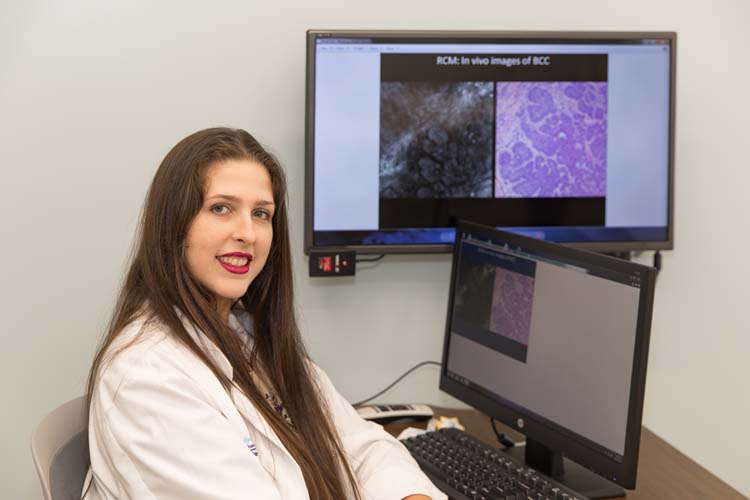
Newly-arrived Scully Welsh Cancer Center dermatologist and surgeon Dr. Lilia Correa is excited about a “cutting edge” tool at her disposal that does not require any actual cutting.
“There is a very cool tool we have here that’s called confocal microscopy,” Correa says.
“I did a specialty in this area and [Scully Welsh director] Dr. Grichnik is also an expert reader of it, so we’re both very keen on it and it’s already available to patients here.”
According to Correa, in its simplest terms, confocal microscopy is a virtual biopsy.
“In other words,” she says, “it’s having a biopsy of the skin without the pinching or the cutting or the scalpel or anything. It’s more or less putting a microscope on the skin and seeing. That’s it.
“It’s a very good, for example, for lesions on the face,” Correa explains, “where we don’t want to create a scar but we do want to make sure it’s not skin cancer. This is where the confocal microscopy can play a great role.”
Besides offering virtual biopsies, Correa treats a variety of skin cancers, specializing in Mohs surgery. She also performs posterior complex reconstruction – borrowing skin from other sites after layers of skin have been removed from a cancerous site.
Mohs micrographic surgery is “the most effective technique for treating the two most common types of skin cancer: basal cell carcinomas and squamous cell carcinomas,” according to the Skin Cancer Foundation.
First developed in the 1930s by Dr. Frederic Mohs, the American Academy of Dermatology says this technique offers, “a unique benefit” in that, “during surgery, the surgeon can see where the cancer stops. This isn’t possible with other types of treatment for skin cancer.”
The Mayo Clinic explains that, “During Mohs surgery, thin layers of cancer-containing skin are progressively removed and examined until only cancer-free tissue remains.”
Aided by her own good vision, special magnifying loops and a local anesthetic, Correa is able to cut away pretty much any cancerous layers of skin ensuring that the cancer is gone using what is generally considered to be a painless outpatient procedure.
After removing each layer of skin, she examines it under a microscope in an on-site lab, repeating the procedure until no cancer cells remain and sparing as much healthy tissue as possible.
To the layman, it almost sounds like peeling the layers of an onion and Correa agrees. “I think,” she says with a smile, “that is a pretty good way of explaining it.”
A former Mohs and Dermatologic Oncology Fellow at the Morristown Medical Center in New Jersey, chief resident at the Robert Woods Johnson Medical School’s dermatology department at Rutgers University and visiting resident at New York’s Memorial Sloan Kettering Cancer Center, Correa can’t help but connect the dots between that onion skin analogy and Mohs surgery.
“Essentially, this is a technique that was developed for areas of the body where you cannot take a lot of skin,” she explains. “For example, the face, the hands or the feet; because if you do, then you may run into vital structures. So, you actually want to spare as much skin as possible.”
Add the areas around the eyes, nose, lips, ears, scalp, fingers, toes or even the genitals and you’ve got a decent roadmap of where Mohs surgery is most commonly done.
Tactfully, Correa manages not to bristle at the suggestion that – at least in some cases – Mohs surgery might be considered cosmetic surgery.
“It’s not cosmetic because it’s essentially a procedure that we use to cure cancer,” Correa states flatly. “So, by definition, it’s something that we do for your health. Usually cosmetic surgery is something that is not medically necessary and is done more to enhance patients’ appearances or tastes but in this case it’s something that is medically necessary. We have to treat the cancer. I do my best to make it as cosmetically pleasing as possible but in its essence, it’s not cosmetic surgery.”
Dr. Lilia Correa is with the Scully Welsh Cancer Center. The phone number is 772-226-4800.



